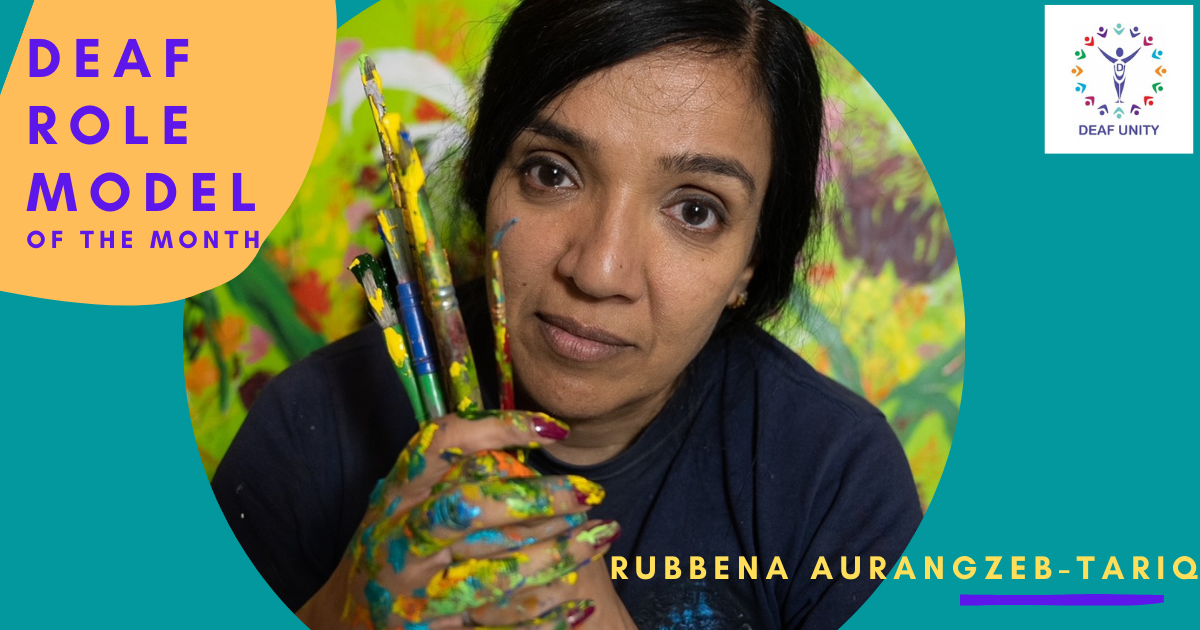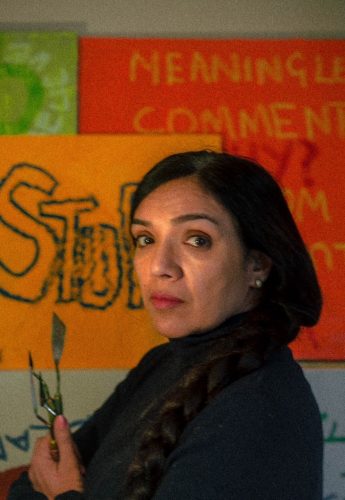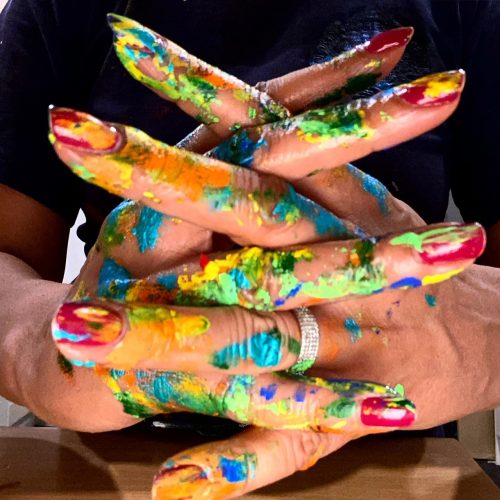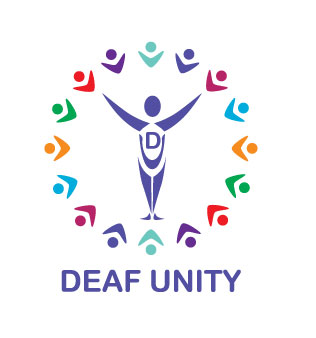
Each month we invite an inspirational or outstanding deaf role model to share their story. From what they’ve learnt, to what they wish they’d have known and their best deaf tips.
This month meet Rubbena Aurangzeb-Tariq, an accomplished Deaf artist and therapist, who became the first Deaf Asian Muslim Pakistani to train as an art therapist in the UK. She shares with us her journey to embrace her deaf identity, her artistic talent and using those to support and inspire others in the community. She is passionate about giving a voice and platform to Deaf ethnic women.
Scroll down for the transcript of this BSL interview.
Find out more about Rubbena and her work here.
Transcript
1. Hi Rubbena! Congratulations on being a Deaf Role Model – tell us about yourself?
I was born deaf in Surrey of Pakistani heritage and attended mainstream education in a ‘Partially Hearing Unit (PHU)’. I achieved four degrees, training as an Artist and Art Psychodynamic & EMDR Psychotherapist. I work as a freelance artist and therapist and also work two days a week in the NHS Deaf CAMHS. I am married with two children.

2. What is your deaf story?
Although I was born deaf in the UK it wasn’t diagnosed until I was seven years old. I had no clear speech and it was assumed that I may have had a mental disability and was a slow learner. My parents did not speak English and couldn’t enquire why I was always very tearful at school and begging to not be left there. When my deafness was diagnosed it was a huge shock for my parents and it distressed them that it wasn’t picked up at an earlier age. My mother was advised that to help develop my speech one spoken language should be used at home. Therefore, she attended evening classes to learn English (taking me with her) and at home everyone had to speak English to support me.
I attended a PHU with other deaf children. It used an ‘oral’ educational approach and we had to wear radio aids. I began to develop clearer speech when I moved to the unit but the environment was very oral and reliant on technology. The Deaf community came later in my early twenties when I moved to London to attend university. I was introduced to the BSL-world through City Lit Centre for Deaf people. They hosted events where deaf students could meet each other. I was very surprised to see the diversity of deaf students there, as I was the only one from my school that had attended university.
3. What was your experience of education as a deaf person?
I started in a hearing primary school before it was discovered that I was deaf, this was the worst experience with no friends and no support from teachers.
When I then went to a primary school with a deaf unit I took a while to settle, as I had no language to communicate when I was seven years of age. But I became happier learning and developed speech to communicate. With some teachers I felt they did not support ethnic children to thrive. I was attached to one teacher who was very supportive and opened up the world to me. We are great friends today. I was offered to do the Mary Hare entrance exam but my class teacher did not support me to achieve this.
At secondary school there were less deaf children and this was the most difficult time, but I had to survive as there was no other choice of school. Teachers were tougher but there was some support from the unit. In my annual report about my future career path they wrote that: ‘Rubbena can cook, sew, draw and help the family shop.’ Luckily my mum insisted that I had to continue studying English and Maths alongside Art!
During A-levels and GCSEs I was the only deaf person in my local college, so I had a difficult start learning how to make hearing friends and how to communicate with them. Teachers also did little to support me to achieve.
When I did my BTEC I started to rebel as I was placed on a lower level course but I demanded to learn just like my hearing peers. I achieved a double distinction and was awarded Student of the Year. I was popular with my hearing peers and we had a great time, discovering the joy of socialising.
I attended four universities, part of the reason being that there were no jobs so I continued with my education. My experience of higher education was mixed. By the time I did my third degree in Art Psychotherapy I requested BSL interpreters as the subject involves complex language and is an intensive therapeutic learning environment. I was fluent in BSL and had level 2 by the age of twenty-six. I discovered the BSL community through friends and attending courses. As a deaf person the educational experience is never easy, presenting challenges in trying to understand jargon and absorb information. Writing in English took a lot of time. I had to re-write my essays several times to get them right and pass, so I had to have a lot of patience to keep doing this. I had to convince the universities that I could do these courses especially when half-way through two of my degrees I became pregnant but carried on studying which wasn’t easy.
4. Have you faced any obstacles or challenges from being deaf and how have you overcome these?
The worst one was when the university told me I had to stop my degree to have a baby and come back after 5 years, whereas there was a hearing student who was also pregnant and was allowed to carry on! I had to fight to limit my academic break to one year.
English is difficult but writing using therapeutic language with new BSL vocabulary created even more onerous obstacles. Throughout almost all my education teachers/lecturers did not talk to me to support me. I had to guess about the teaching a lot and this was quite a challenge to cope with, copying my peers, or asking them what I needed to do because they were afraid to talk to a deaf student making it harder.
I learned to ask teachers directly what I needed to do from the start, what the outcomes and expectations were and use that as a basis to complete my work. I realised student peers that I was asking questions of were not clear themselves so I was making mistakes! This has helped me to become assertive and confident.
5. What inspired you to become an artist?
When I was nine or ten it was noticed that I drew well – copying objects at primary school – so in secondary school my art teacher asked my parents to get me a sketch book to keep drawing, which they did. I was encouraged rather than inspired to become an artist. I drove places with my large easel, drawing/painting boxes, and painted places like canals and forests. It carried on from there and I have never stopped. My journey always inspires me to be creative.

6. Your work explores your experience of life and delves into the deeper issues in society. What issues are you passionate about?
My artworks focuses on my journey growing up, experiencing many challenges, barriers between cultures, languages, identity so this helps me become more creative. I am passionate about making a voice for Deaf ethnic women. Every one of us should have the right to have a choice, a voice to express our views and to be respected equally by our peers/families as not to be seen as a taboo of shame or sin, as the Asian community views my deafness.
7. After achieving your degree and MA in fine art, what motivated you to go on to study art psychotherapy?
When I completed my BA (Hons) in Fine Art, I did not have the knowledge or skill to apply for work, but got odd short-term creative/workshop work in schools and the community. I did an MA in Fine Art to support me in developing my writing ability. Then I got married and was approached by a Deaf man at a Deaf club who asked ‘what are you doing now?’ He mentioned art therapy at Springfield Hospital, so I volunteered there to explore it for myself. I liked how it can support deaf people to express their emotions and thoughts and I became the first Deaf Asian Muslim Pakistani to train as an art therapist in the UK. Deaf mental health services motivated me to study further to gain a licence to practice.
8. Can you tell us a bit more about what art psychotherapy involves and who benefits from it?
Art Psychotherapy allows a therapist to think more creatively about the client’s emotions and thought processes. Here the therapist can investigate the triggers, traumas, self-harming impulses, depressive feelings and thoughts. Then they can support them to put it into focus, allowing them to understand it better reprocessing it to cope with difficulties in a more manageable way. In these sessions there is a choice to just draw, paint, allowing one to feel safe and secure to express the unconscious and the therapist will support understanding images and the relationship to their thoughts.

9. How important is it that deaf people have access to therapists who communicate in their native BSL rather than having to access therapy through an interpreter?
In modern times it seems to have become a trend to have therapy. We all need it at some point in our lives when we struggle to understand some things. It is the same for deaf and hearing, but for deaf people it is so important to request a counsellor or therapist that best meets their needs. Not just accepting any that are given, one is entitled to request a change of counsellor/therapist. As a deaf person seeking therapy it is useful to ask for a visual therapist. It can be an art therapist, play therapist, drama therapist or music therapist depending what works well for one as counselling can be limited to spoken language with interpreters. This often has it own challenges with three-way communication, and sometimes counsellors have little understanding about deaf people and their issues.
10. What advice would you give to young deaf artists who want to develop a career in the arts?
Families often don’t see art as a career, but many people I know even with an undergraduate art degree have achieved great things: in the arts or in other walks of life. Art education is equal to any other types of education. It educates us to learn, become more aware, more informed and find a positive career path. I have to be honest and say that the art world is a tough business and there are times with little money but if you believe in yourself you can achieve anything.
Developing a career in the arts will open doors in graphic design, website development, social media platforms, textiles, fashion clothes, jewellery, ceramics, photography – a never-ending range of choices. Arts with the‘s’ means that you will learn broadly before you choose what to specialise in. Language is creative, we can develop it in written simple forms to mean many things, barriers are removed because there are no barriers or limitations in the arts.
11. Who inspires you and why?
Funnily enough I would answer that with a ‘what’ inspired me rather than ‘who’. When I was growing up I was absolutely entranced by comics. I loved ‘The Beano’, ‘The Dandy’ and ‘Tin-Tin’. I think I got a spirit of adventure and willingness to take risks from Tin-Tin. Dennis The Menace and Gnasher inspired me with their anti-authoritarian naughtiness and playfulness!
12. What ways do you think hearing people can be allies to the deaf community? Any DOs and DON’Ts?
Do’s:
• Inspire hearing people to see that it is possible for us to achieve equally!
• Encourage them to see your skill and ability rather than the deafness or disability.
• Listen to their views and share yours
• Good time management is a key to showing your commitment
Don’ts:
• Don’t give up easily because of language barriers or having no interpreters – most hearing people have no idea how or where to book. Offer to help them do it.
• Don’t assume people are not helping out of bad faith. Most do not have the knowledge to know how to talk to a deaf person, so educate them as every deaf person has different needs and levels of communication.
12. 3 top tips for deaf people?
1) Share your career ideas with families/friends to get support
2) Travel and socialising inspires creativity to build a portfolio
3) Learn about hearing cultural norms (similarity and differences with deaf culture)
4) Improve communication behaviours to engage with others, it makes the world of work less stressful
Sign up to our newsletter for more content like thisTo read more inspirational role model interviews, take a look here.
Looking for more support? We’ve made it our mission to improve the lives of deaf people everywhere. Check out Deaf Unity’s projects to find out what we can do for you. If you’d like to get in touch, contact us here.


This is a wonderful story and tribute to Rubbena’s tenacity.
It also highlights the failings and limitations of systems run by hearing people. I really hope these can be changed by more understanding of the experiences of deaf people in our communities.